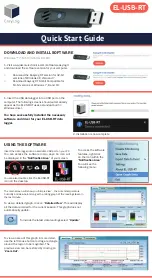
Section 5. Overview
68
Analog sensors output a continuous voltage or current signal that varies with the
phenomena measured. Sensors compatible with the CR3000 output a voltage.
The CR3000 can also measure analog current output when the current is
converted to voltage by using a resistive shunt.
Sensor connection is to H/L terminals configured for differential (DIFF) or
single-ended (SE) inputs. For example, differential channel 1 is comprised of
terminals 1H and 1L, with 1H as high and 1L as low.
5.2.2.1 Voltage Measurements — Overview
Related Topics:
• Voltage Measurements — Specifications
• Voltage Measurements — Overview
(p. 68)
• Voltage Measurements — Details
(p. 380)
•
Maximum input voltage range:
±
5000 mV
•
Measurement resolution range: 0.67 µV to 1333 µV
Single-ended and differential connections are illustrated in the figures Analog
Sensor Wired to Single-Ended Channel #1
(p. 69)
and Analog Sensor Wired to
Differential Channel #1
(p. 69).
Table Differential and Single-Ended Input
Terminals
(p. 69)
lists CR3000 analog input channel terminal assignments.
Conceptually, analog voltage sensors output two signals: high and low. For
example, a sensor that outputs 1000 mV on the high lead and 0 mV on the low has
an overall output of 1000 mV. A sensor that outputs 2000 mV on the high lead
and 1000 mV on the low also has an overall output of 1000 mV. Sometimes, the
low signal is simply sensor ground (0 mV). A single-ended measurement
measures the high signal with reference to ground, with the low signal tied to
ground. A differential measurement measures the high signal with reference to
the low signal. Each configuration has a purpose, but the differential
configuration is usually preferred.
A differential configuration may significantly improve the voltage measurement.
Following are conditions that often indicate that a differential measurement
should be used:
•
Ground currents cause voltage drop between the sensor and the signal-
ground terminal. Currents >5 mA are usually considered undesirable.
These currents may result from resistive-bridge sensors using voltage
excitation, but these currents only flow when the voltage excitation is
applied. Return currents associated with voltage excitation cannot
influence other single-ended measurements of small voltage unless the
same voltage-excitation terminal is enabled during the unrelated
measurements.
•
Measured voltage is less than 200 mV.
Содержание CR3000 Micrologger
Страница 2: ......
Страница 3: ......
Страница 4: ......
Страница 6: ......
Страница 30: ......
Страница 34: ......
Страница 36: ......
Страница 96: ......
Страница 200: ...Section 7 Installation 200 FIGURE 42 Running Average Frequency Response FIGURE 43 Running Average Signal Attenuation ...
Страница 485: ...Section 8 Operation 485 8 11 2 Data Display FIGURE 110 Keyboard and Display Displaying Data ...
Страница 487: ...Section 8 Operation 487 FIGURE 112 CR1000KD Real Time Custom ...
Страница 488: ...Section 8 Operation 488 8 11 2 3 Final Storage Data FIGURE 113 Keyboard and Display Final Storage Data ...
Страница 489: ...Section 8 Operation 489 8 11 3 Run Stop Program FIGURE 114 Keyboard and Display Run Stop Program ...
Страница 491: ...Section 8 Operation 491 FIGURE 116 Keyboard and Display File Edit ...
Страница 495: ...Section 8 Operation 495 Low power standby whenever possible Low power bus sets bus and modules to low power ...
Страница 496: ......
Страница 502: ......
Страница 564: ...Section 11 Glossary 564 FIGURE 126 Relationships of Accuracy Precision and Resolution ...
Страница 566: ......
Страница 594: ......
Страница 598: ......
Страница 600: ......
Страница 602: ......
Страница 624: ......
Страница 642: ......
Страница 643: ......
















































